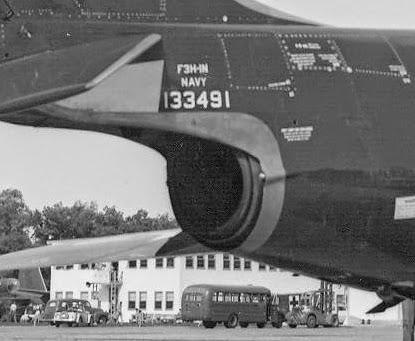There was an intermediate step, the Westinghouse J40-powered F3H-1N, which disappointed to say the least. About half of the 60 built never even received engines, which was probably a good thing since J40 engine failures in the XF3H and F3H-1N resulted in three dead-stick landings and four crashes, two of them fatal.
Converting an F3H-2 to an F3H-1N is non-trivial but doable. The major changes are the wing planform, the one-piece windscreen, and the afterburner. (It also had the early, longer beaver tail; see the post referenced above.)
The good news is the -1N wing (dashed lines) is roughly the same as the -2's forward from a line running along the aft side of the wheel well to the trailing edge of the wingtip.
However, the change of airfoil inboard suggests that it wasn't as simple as adding structure to the aft side of the -1's wing torque box:
There was a small fence on the aileron instead of a chord-wise one on the wing.(What looks like an outboard aileron is really the marking of a no-step area.)
Another view of the aileron and flap from the right side (note the fuel dump mast between the aileron and flap).
This view of the later XF3H-1 flap and aileron that were carried over to the F3H-1N shows how the forward edge of the flap extended farther forward on the lower side of the wing. (Note that the big wing fence was not carried over.)
The one-piece windscreen is probably the biggest challenge:
Since there was no flat windscreen center pane on which to project the gunsight reticule, the glass had to be included on the gunsight itself.
Illustrations of the F3H-1 cockpit indicate that the gunsight was slightly offset to the left of center.
Also note the blank panel where the radar scope was to be located. Although the F3H-1 was originally intended to have a visual-assist radar, the F3H-1Ns were delivered with an APG-30 range-only radar. (The small instrument on the blank panel is a range indicator.)
The Westinghouse J40 afterburner nozzle was a clam-shell type, with the split line vertical. The clam-shell actuators were covered by a small fairing on each side of the aft fuselage. The nozzle didn't extend as far out of the opening in the fuselage as the J71's.
Additional details are provided here: http://tailhooktopics.blogspot.com/2021/02/westinghouse-j40-afterburner-nozzle.html
This illustration provides a comparison of the F3H-1N with one completed with the -2 wing and the Allison J71 engine.
The auxiliary-air inlet on the side of the fuselage was rarely seen open. It was also present on the early F3H-2s but subsequently deactivated. The panel lines remained, however.
One of the unusual aspects of this paint scheme is that in addition to the unpainted metal (or aluminized epoxy paint) around the tailpipe, the tailboom under the stabilator appears to have been painted an off-white as was the inner half of the underside of the stabilator, while the outer half of the stabilator was blue (it looks light colored in the following picture but I think that's a reflection of the concrete).













Small 'R2D2'-like object behind ejection seat in the windscreen view is AS-313 ARN-6 Radio Compass Bird Dog loop ADF antenna.
ReplyDeleteComing back to this years later, if I was looking for a creative way to dispose of an emhar F3H, would cutting trailing edges of the wings back to the rear spar and replacing them with new ones get me most of the way to an F3H-1? A sketch-model, something I won't feel bad about if it all goes J40 shaped.
ReplyDeleteI take it that structurally, both wing designs are much the same. I wonder if the flexing around the ailerons of the -2 was down to a cobbled together structure aft of the original wing box.
A pretty careful comparison of McDonnell drawings of the root (aircraft centerline) airfoil of the -1 and -2 suggests that the change in contour began in the vicinity of the maximum airfoil thickness (i.e. forward of the aft spar) of the -1 but the difference is pretty small and there is an appearance of reflex in the aft part of the -2 airfoil needed to extend it farther aft. I'll add that to the post.
DeleteThe most notable feature of your new drawings - to my eye - is the lack of camber on the leading edge on the F3H-1 wing. I should have guessed that.
DeleteThe Incomplete Guide to Airfoil Usage lists "NACA 0008.6-1.08 41/1.20 mod" at the root and "NACA 0006.4-1.16 38/1.14 mod" at the tip. The Emhar kit measures about 5.6mm thick at the root and about 3mm at the tip. If you compare that to the 1/72 chord of the F3H-1 wing, it's just about perfect for 8.6% and 6.4%.
It's nice the way the trailing edge extension meets the original trailing edge at the geometrical tip.
The cambered leading edge was an aerodynamic feature that became popular at the time on swept-wing Navy carrier-based jets. It was added during the production of the A3D-2 and FJ-3 and introduced with the production of the F9F-8 Cougar. It was considered for addition to the A4D but not implemented. The F8U's leading-edge flap could be drooped slightly by the pilot for the L/D benefit at cruise speed.
Delete